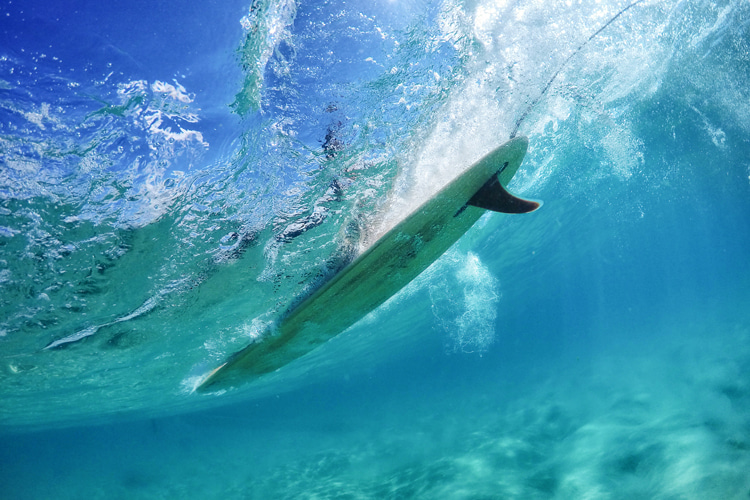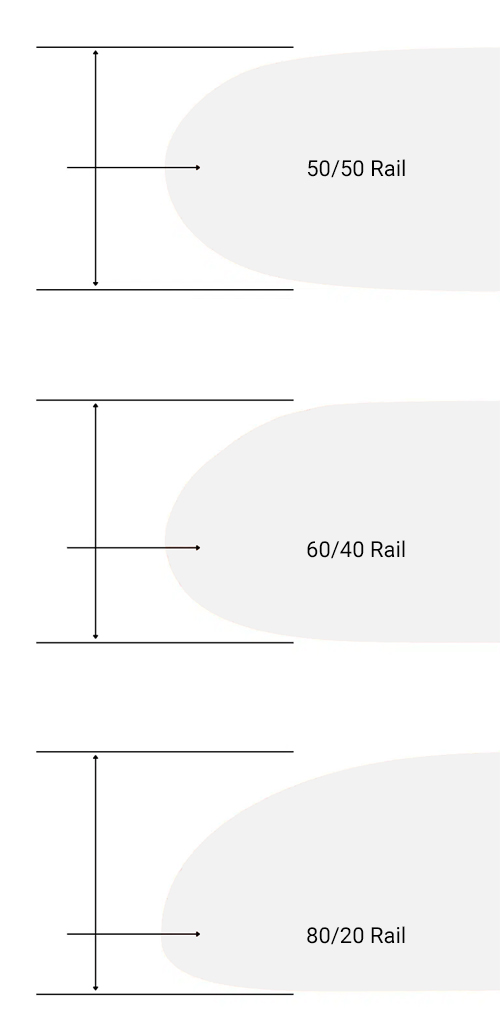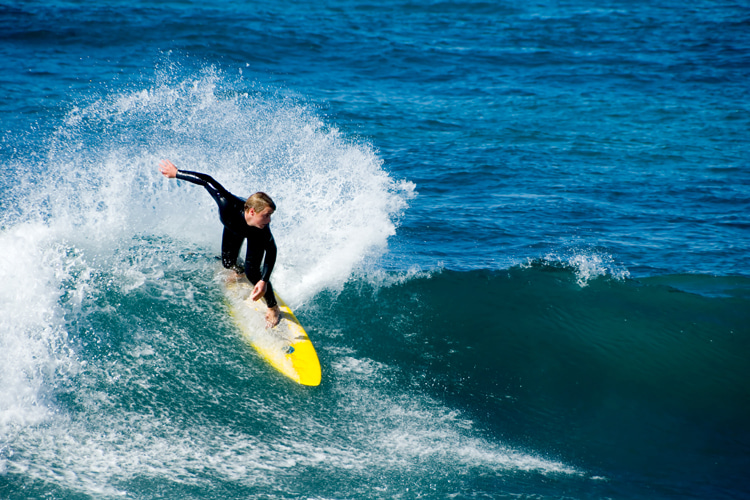Rails are one of the key elements of surfboard shaping.
Whether you're "burying a rail" (setting a deep, powerful turn) or "grabbing the rail" (when the surfer grips the rail for added stability), you have to count on them on each ride.
And sometimes, when you "dig the rail" too much (to have an edge sink into the water unexpectedly), you often wipe out.
Ultimately, an advanced surfer is always a rail-to-rail performer, shifting weight from toe to heel side.
The rails run along the sides of the surfboard, extending from nose to tail and from deck to bottom.
They might seem simple, but their design is anything but, as their rounded perimeters are elliptical on both axes.
Surfboard rails remained an afterthought until the closing years of the 1960s.
Prior to that time, most boards featured some form of a gentle, egg-shaped rail characterized by a symmetry in the curve extending from the deck to the perimeter, mirroring the curve that emanated from the underside of the board.
The transformation of surfing was marked by the shortboard revolution, commencing in 1967, a mere two-year period that witnessed a dramatic metamorphosis.
Boards were reinvented, evolving from the ungainly 10-foot structures of the past to sleek and streamlined models measuring under seven feet in length.
This revolution cast a spotlight on the artistry and function of rail design, giving it newfound prominence in the surfboard-shaping world.
The magic of the rails lies in their ability to interact with the water, and here, every small detail counts. Here's what they do:
- Turning and Stability: The rails guide the direction of the surfboard, allowing it to make sharp turns or stabilize during a glide. The subtle dance between the rail's curve and the wave's touch creates a symphony that only the surfer can feel;
- Speed and Resistance: The shape of the rail influences how the water flows along the board. Hard rails tend to minimize resistance, while full rails create more drag but add stability. It's a delicate balance between speed and control;

Types of Surfboard Rails
There are three main families of surfboard rails:
- Hard Rails;
- Soft Rails;
- Tucked Under Edge Rails;
Hard Rails

Hard surfboard rails are to surfing what a sharp blade is to a chef: precise, efficient, and designed to cut cleanly.
Unlike the gentle curve of a soft rail, hard rails boast a more aggressive and sharp curvature, bearing less resemblance to a symmetrical oval and more to a well-defined edge.
Imagine looking at the transition from the top of the surfboard deck to the bottom and seeing what appears to be a "ledge" or a keen edge.
This isn't accidental; it's exactly this sharpness that enables the board to slice through the water with the precision of a knife.
The design of hard rails isn't just about aesthetics; it's a masterful innovation for performance.
The flatness of the rail shape offers an expressway for water to pass quickly and efficiently by the parts of the board that sit in the water.
Rather than clinging to the board, the water releases, like a dancer's graceful spin, enhancing the surfboard's performance throughout turns.
This means a surfer on a hard rail board can navigate turns and waves with the agility of a ballet dancer or the deftness of a skilled pilot, executing maneuvers with an exhilarating blend of control and grace.
Hard rails provide more planing and more speed than soft rails but could be tricky to manage on big or flat waves.
Soft Surfboard Rails

Soft board rails are like the gentle curves of a winding road, less sharp and aggressive than their hard counterparts.
The shape of these rails isn't just for show; it plays a crucial role in how the board first kisses the ocean's surface and lays the groundwork for the rider's thrilling dance of turns and moves.
Think of soft rails as super round and smooth to the touch, like the edges of a well-worn pebble.
If you're examining a board from the side and you notice an oval shape, you've spotted a soft rail board, a design that's as recognizable as the shape of a friendly smile.
These gentle curves offer something special on the water.
With a fuller feel, soft rails boast more buoyancy, like a supportive friend lifting you up on the waves.
Therefore, soft rails are more forgiving than hard rails.
Perfectly suited for beginners, they are often found on longboards or boards designed for gliding on small waves.
Imagine the oval shape of the soft rail board not slicing through the water but rather inviting the ocean surface to "wrap itself" around the board like a gentle embrace.
This creates an extraordinary bond between the water and the board, granting greater stability as though they're moving in harmony.
However, this close relationship with the water does come with a trade-off.
It makes it harder for surfers to zigzag and make quick changes in direction, like trying to steer a large ship rather than a nimble speedboat.
The soft rails are forgiving but demand a different style of riding, teaching lessons in both grace and patience to those who take up the challenge.
Tucked-Under-Edge Rails
Tucked-under-edge rails provide a compromise blending the best features of hard and soft rails.
They feature the planing capacity of hard rails, with the holding power in subtle turns and the smoother response of soft rails.
It's a balanced formula that can be seen in all-round surfboards.
Types of Surfboard Rail Foil
Imagine a surfboard as a musical instrument and the surfboard rail foil as the fine-tuning that allows it to play just the right note.
It's the delicate ratio at which the rail and body come together, describing how the rail's volume is spread out, like the keys on a piano.
This isn't just a matter of appearance; it's crucial to how the board performs under various wave conditions, affecting where and how the board floats on the water's surface.
Picture the rail foil as a secret recipe, with different ratios cooking up different results on the waves.
When you look at the board from the side, you might notice the apex of the rail, the highest point of its curve.

The most common three mixtures in surfboard rails are:
- 50/50 Rails: Imagine a rail where everything is in perfect balance, like two halves of an apple. The 50/50 ratio means the volume distribution between the rails is exactly equal, the top mirroring the bottom, with the curvature poised right in the center. Think of it as the beginner's best friend, featured on soft rail boards. These boards offer a supportive embrace of increased buoyancy and stability, gently introducing newcomers to the world of surfing;
- 60/40 Rails: Now picture a board that's akin to a versatile all-rounder in a sports team. This 60/40 construction suits both hard and soft rail boards, standing as a go-to standard for those intermediate surfers seeking to step up their game. It marries the agility of a sleek sports car with the stability of a steady cruiser. Often found on funboards and mid-length boards, this design promises the best of both worlds for riders who crave a fresh twist on their wave-riding experience;
- 80/20 Rails: Lastly, enter the realm of the 80/20 foil, the domain of the high-octane professionals. Mainly gracing hard rail designs on high-performance boards, this sharp and incisive edge offers riders the chance to dig in and seize ultimate control over their waves. It's like the steering wheel of a race car, demanding the least amount of effort to turn and maneuver yet also presenting the most challenging mastery;
